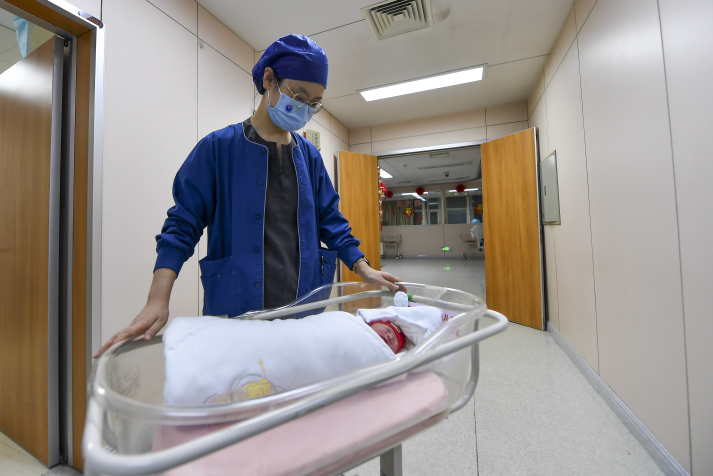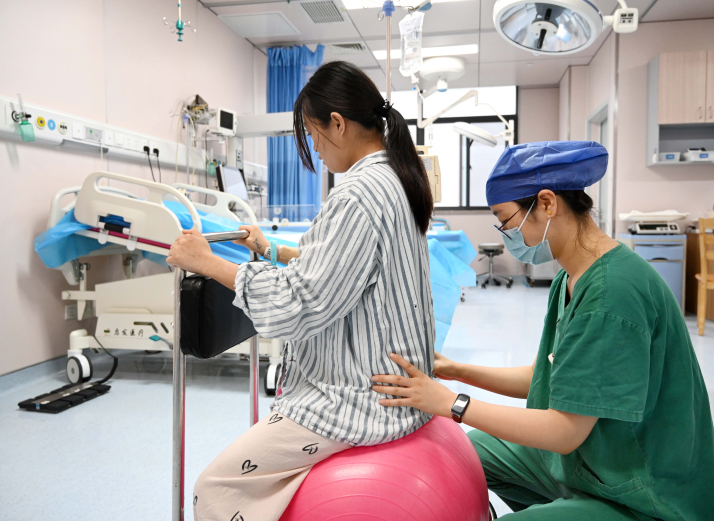| China |
| China's efforts in making childbirth pain-free | |
|
|
 A doctor rolls a newborn out of the delivery room at the Obstetrics and Gynecology Center of the First Bethune Hospital of Jilin University in Changchun, Jilin Province, on January 1 (XINHUA)
Wu Yao, a Beijing resident and mother of two, has had two strikingly different childbirth experiences. Her first delivery came without the relief of epidural anesthesia; for her second, she embraced the jab. "The difference between giving birth to these two children was night and day," she told Beijing Review. Her first child arrived in 2014 at a public hospital, with searing pain for her. "Back then, I simply had no idea of pain-free childbirth," she said. "I thought excruciating agony was just an unavoidable part of bringing a child into the world." When China's universal two-child policy began to be implemented in 2016, Wu planned her second pregnancy. This time, she learned that private hospitals offered epidural services. After consulting doctors, she decided that despite the cost difference, she would deliver her second baby at a private facility, with an epidural. The financial contrast was stark: A public hospital birth, largely covered by insurance, would cost her around 2,000 yuan ($280); the private option, however, demanded over 60,000 yuan ($8,400)—almost entirely out of pocket. Yet she didn't hesitate. Her choice proved right. "Once the anesthesia took effect, it was transformative," she recalled. "It was not completely painless, but any discomfort paled next to the agony of natural labor. The difference was incredible." From agony to ease The so-called painless labor employs epidural or spinal anesthesia technology to reduce the agony of natural childbirth. The very concept of painless delivery only began gaining widespread recognition among Chinese families in recent years. In earlier years, some expectant mothers, fearful of this natural labor pain, proactively opted for cesarean sections. According to a December 2024 report from the National Center for Healthcare Quality Management in Obstetrics, the national cesarean delivery rate reached 47.3 percent in 2023. Beyond cases with clear medical indications for the procedure, a large number of women chose surgical delivery primarily driven by pain avoidance. "Childbirth is a natural physiological process. A cesarean section essentially converts this into a pathological procedure—leaving uterine scarring that creates dangerously thin muscle layers," Mi Weidong, Chief Anesthesiologist at the First Medical Center of Chinese PLA General Hospital, told China Newsweek magazine. "This dramatically increases risks like uterine rupture during subsequent pregnancies." He stressed that popularizing labor analgesia could effectively reduce non-indicated cesarean deliveries. Qu Yuan, Chief Anesthesiologist at Peking University First Hospital (PKUFH), traced the origins of labor analgesia in China back to 1963 in an interview with Health News. That year, PKUFH's anesthesiology department initiated clinical research into pain management during childbirth, establishing its fundamental feasibility. She revealed that systematic efforts to develop labor analgesia gained momentum in the late 1990s. A pivotal moment came in 2001 when PKUFH pioneered a "multidisciplinary labor analgesia team," integrating anesthesiology and obstetrics. The hospital further promoted this model by hosting China's first Labor Analgesia Training Course in 2002, attracting medical professionals nationwide. Progress, however, was initially slow and met with resistance. "At the time, fewer than one percent of Chinese hospitals offered labor analgesia," she said. "Key hurdles included severe shortages of qualified anesthesiologists and deep-seated public skepticism; many families feared anesthesia would impair the newborn's cognitive development." A major shift began in 2018. the National Health Commission (NHC) launched a nationwide pilot program, selecting 913 eligible hospitals as designated pilot sites for labor analgesia services. The momentum picked up in August 2022. Seventeen state agencies, including the NHC and the National Development and Reform Commission, jointly issued guidelines explicitly advocating for expanding the pilot program and enhancing the quality of labor analgesia. Complementing this, the National Healthcare Security Administration pledged to guide local authorities in gradually incorporating eligible labor analgesia techniques into basic medical insurance coverage, contingent upon local fund capacity, and established medical protocols. The results have been nothing short of striking. NHC data revealed that between 2015 and 2022, the rate of labor analgesia within the 913 pilot hospitals surged from 27.5 percent to 60.2 percent. Quite a few provinces, autonomous regions and municipalities have now incorporated related costs into their medical insurance schemes. Today, a growing number of expectant mothers can access labor analgesia in public hospitals. This March, Beijing resident Fang Fei received an epidural during childbirth at Peking University Third Hospital—a public institution—for just 1,500 yuan ($209).  A maternity nurse at Wuyi County First People's Hospital, Zhejiang Province, provides prenatal touch therapy to an expectant mother to ease anxiety and promote relaxation for a smoother delivery on May 9 (CNSPHOTO)
Challenges and prospects A bottleneck in expanding labor analgesia is the severe shortage of anesthesiologists. According to Chinese Medical Association data, China had just 105,000 anesthesiologists and fewer than 25,000 specialized anesthesia nurses in 2023—far below demand. This deficit is particularly acute in grassroots hospitals. Recognizing this challenge years before the 2018 pilot initiative, health authorities had already outlined workforce development targets in policy documents: growing the anesthesiologist workforce to 140,000 by 2030 and 160,000 by 2035. Beyond staffing numbers, Xu Mingjun, Director of Anesthesiology at Beijing Obstetrics and Gynecology Hospital (affiliated with Capital Medical University), highlighted operational complexities. "Labor analgesia requires intensive collaboration between obstetricians, anesthesiologists and midwives," he told newspaper Guangming Daily. "A dedicated team must provide continuous monitoring throughout labor—often lasting hours—to ensure safety and comfort." The prolonged, resource-intensive nature of this team-based care creates economic disincentives for some hospitals. He advocated for robust incentive mechanisms and improved compensation to address this, alongside strengthening undergraduate anesthesia programs to tackle the root cause. Higher cost and insurance barriers further hamper adoption. "Over half of China's provinces still lack dedicated fee schedules for labor analgesia," Mi Weidong said. "Subsequent insurance coverage addresses affordability—both are essential for widespread implementation." In June 2024, national healthcare pricing guidelines created distinct billing codes for labor analgesia, doula services, and birth companionship. Four months after that, the State Council, the country's top state administrative organ, prioritized enhancing maternity insurance coverage, explicitly directing provinces to include qualified labor analgesia in reimbursement schemes. Some regions are leading implementation. Since 2021, Shenzhen, a tech hub in south China, has bundled qualified labor analgesia services into its universal maternity insurance coverage. According to a government document released in June, all third-grade (top-notch) medical institutions that offer obstetric services are expected to provide painless childbirth options by the end of 2025; and by 2027, the coverage will be expanded to all second-grade and higher medical institutions with obstetric departments. "AI-powered centralized monitoring hubs could track vital signs across multiple delivery rooms in real-time. This would enhance efficiency, alleviate workload pressures and ultimately make pain-free childbirth accessible to more mothers," Xu said. BR (Print Edition Title: The Pain Gap) Copyedited by Elsbeth van Paridon Comments to yuanyuan@cicgamericas.com |
|
||||||||||||||||||||||||||||||
|